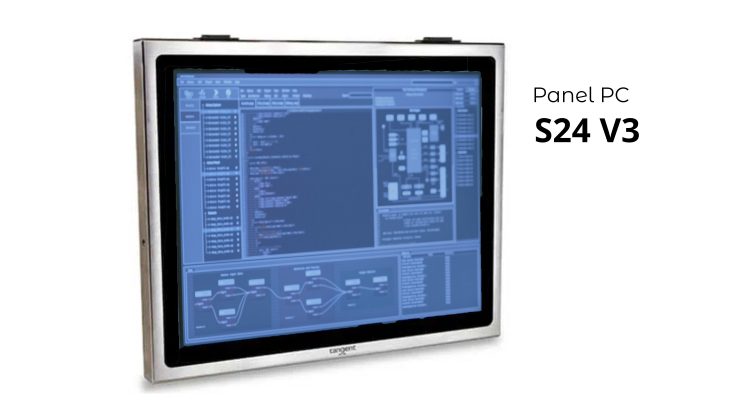
Industrial Panel PC: Tangent’s S24 V3
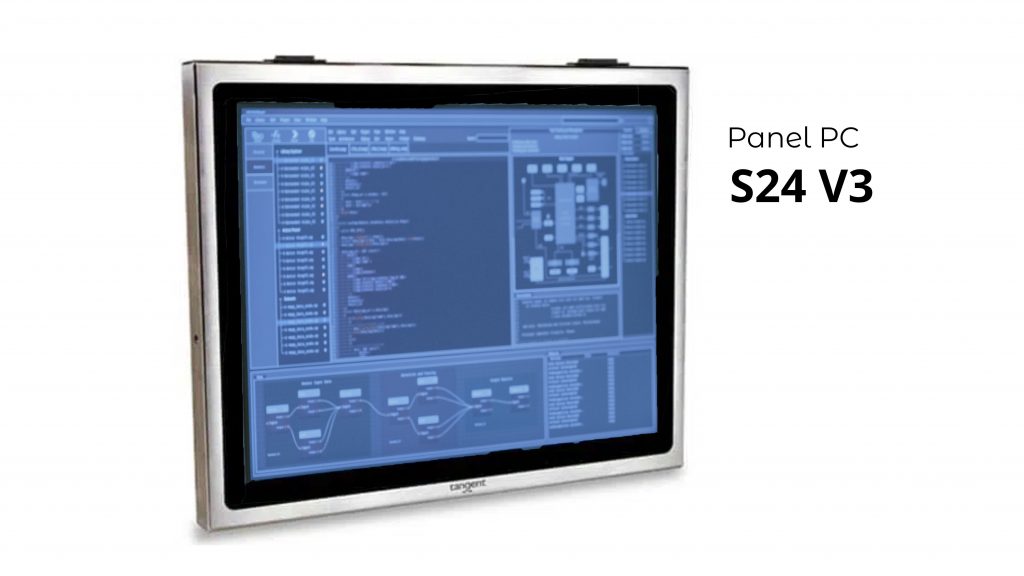
Industrial Panel PC: Tangent’s S24 V3
Tangent’s S24 is a rugged, compact, and highly configurable industrial panel PC designed for use in harsh environments. It offers powerful processing capabilities, up to 32GB of RAM, and a range of connectivity options, including USB, Ethernet, Wi-Fi, and Bluetooth. It is designed with security in mind, featuring TPM and Intel vPro technology, and is suitable for a wide range of industrial applications.
4 Industrial Panel PC Features:
24″ LCD Display:
24″ display size is a sweet spot for many users, striking a balance between screen real estate and physical size. It is large enough to allow for comfortable viewing of multiple windows or applications side-by-side, yet not so large that it becomes unwieldy or takes up too much space.
The 16:9 aspect ratio of the display is ideal for widescreen viewing. This aspect ratio is also widely adopted in modern displays and is compatible with most software applications.
The FHD resolution of 1920 x 1080 pixels provides clear and crisp images with high detail and definition. This is particularly important for tasks that require a high degree of visual clarity. The FHD resolution also ensures that text is sharp and easy to read.
1920 x 1080 resolution is a popular and widely supported standard that ensures compatibility with most software and hardware platforms. This makes it easy to integrate the display into a variety of setups, whether it’s a desktop computer, laptop, or other device.
Overall, the combination of a 24″ display size, 16:9 aspect ratio, and FHD resolution offers an excellent balance of screen real estate, visual clarity, and compatibility. These features make it a popular choice for a variety of applications.
Brightness of 250 cd/m2
Brightness of 250 cd/m2 is considered to be a standard level of brightness for most displays. It is bright enough to ensure that images and text are clear and easy to read, even in well-lit environments. This is important for tasks that require a high degree of visual clarity.
Brightness level of 250 cd/m2 strikes a balance between visual clarity and eye comfort, avoiding eye strain.
3000:1 Contrast Ratio
The high contrast ratio of the S24 V3 ensures that images and text appear clear and crisp on the display. This is particularly important for tasks that require a high degree of visual clarity. A high contrast ratio ensures that colors are well-defined and that details are visible, even in darker areas of the image.
The S24 high contrast ratio provides a more immersive viewing experience. The darker blacks and brighter whites help to create a more vivid and engaging image imperative for industrial applications where detailed monitoring is essential.
As with brightness, a high contrast ratio can help to reduce eye strain and fatigue, particularly when working for long periods of time in front of the display. A display with a low contrast ratio may require the user to strain their eyes to distinguish between different shades of color or detail, which can lead to eye fatigue and discomfort. The S24 provides ideal optical conditions for staff.
Projected Capacitive Touch Screen (PCT)
Accuracy and responsiveness in one. PCT can detect even the slightest touch, making it ideal for precise input such as drawing, handwriting, or other fine motor skills. PCT touch screens in the S24 V3 panel PC support multi-touch gestures such as pinch-to-zoom or swipe.
PCT touch screens are also highly durable and resistant to scratches and damage, making them suitable for use in industrial environments or public spaces. They are easy to clean and maintain, and their robust design ensures that they can withstand heavy use.
SUS 304 Stainless Steel Enclosure
There are 5 traits that make the S24 V3 panel PC stainless steel enclosure ideal:
- SUS304 stainless steel enclosure has excellent corrosion resistance properties, which makes it ideal for use in environments that are prone to moisture, humidity, or exposure to harsh chemicals. The S24 V3 panel pc is built to withstand harsh environments.
2. US304 stainless steel is a very durable material that can withstand impacts, scratches, and other types of damage that may occur in an industrial setting.
3. Aesthetic appeal: SUS304 stainless steel has a high-quality finish and a modern look that enhances the overall appearance of the S24 V3 panel PC. This is important for applications where the panel PC is visible to customers or visitors.
4. Easy to clean: SUS304 stainless steel is easy to clean and maintain, which is important in environments where hygiene is important, such as food processing facilities. It is also resistant to staining, which can help to maintain its appearance over time.
5. Resistant to high temperatures: SUS304 stainless steel enclosure has a high melting point and is resistant to high temperatures, making it ideal for use in applications where heat is a concern, such as industrial ovens or furnaces.
From the optics: such as 16+ million colors, brightness that’s easy on the eyes, and contrast for vivid details, to the screen and finally the enclosure- one can see that Tangent’s S24 V3 was carefully curated to provide the best user experience. Industrial applications, be it for government and correctional facilities to car washes or food processing facilities, require the upmost reliable computers. The S24 V3 panel PC stainless steel enclosure is designed not to melt or freeze, yielding steadfast performance in extreme temperature applications.
Pinch your fingers to zoom or review and monitor camera footage for hours without eye strain. The S24 V3 was made with staff in mind. What’s more, this powerful panel PC holds high-performing treasures within the stainless steel enclosure.
Performance Hardware
The S24 V3 industrial PC is highly configurable, with a range of options for processors, memory, storage, and graphics. Customers can choose from a variety of processor options, including Intel Core i5 and i7 processors, and up to 32GB of RAM. This makes it possible to customize the computer to meet the specific needs of each application.
Another key feature of the S24 v3 panel PC is its compact design. The computer is just a hair over 2.5 inches thick, which makes it easy to mount in tight spaces or on walls. This compact design also makes it ideal for use in applications where space is at a premium, such as in vehicles or on factory floors.
The S24 V3 industrial PC also comes with a range of connectivity options, including multiple USB and Ethernet ports, as well as support for Wi-Fi and Bluetooth. This makes it easy to connect the computer to other devices and networks, and to share data between them.
In addition, the S24 V3 panel pc is designed with security in mind. It includes features such as TPM (Trusted Platform Module) and Intel vPro technology, which help to ensure that data is protected from unauthorized access or tampering.
Overall, the S24 v3 is an impressive industrial panel PC that offers a wide range of features and capabilities. Its rugged design, powerful performance, and versatile configuration options make it an ideal choice for a variety of industrial applications. Whether you are looking for a computer for use in a factory, warehouse, or vehicle, the S24 v3 panel PC is a excellent selection for your industrial needs.
Shop the S24 v3: https://www.tangent.com/industrial-Pcs/panel-pc/s-series-v3/
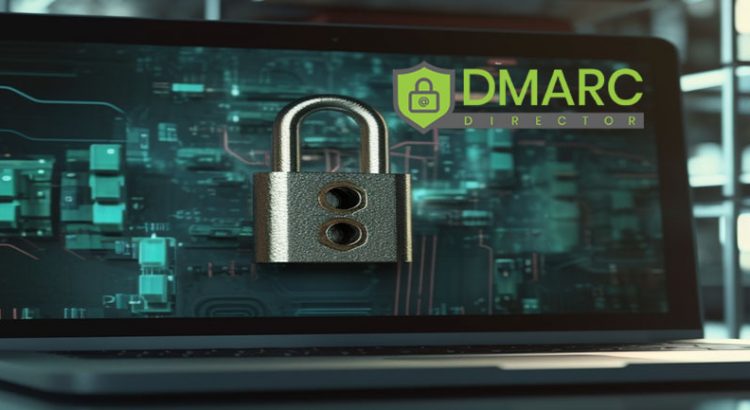
Protecting Your Business from Email Fraud with DMARC
Why a DMARC Business SaaS Solution is Worth the Investment
DMARC, which stands for Domain-based Message Authentication, Reporting, and Conformance, is an email authentication protocol that helps protect your domain from email fraud and phishing attacks. It provides email domain owners with the ability to indicate that their emails are protected by SPF (Sender Policy Framework) and/or DKIM (DomainKeys Identified Mail) authentication methods, and provides instructions for email receivers on how to handle unauthenticated emails.
DMARC works by allowing domain owners to specify which email authentication methods they are using, and what actions to take on emails that fail authentication. If an email fails DMARC authentication, it can be quarantined, rejected, or sent to a designated mailbox for further analysis.
The benefits of DMARC are clear: it helps prevent email fraud and phishing attacks, protecting your brand reputation and customer trust.
But why should you consider buying a DMARC Business SaaS solution?
First, DMARC can be complex to set up and manage. A DMARC Business SaaS solution can simplify the process by providing a user-friendly interface for configuring DMARC policies and monitoring email traffic. This can save your IT team valuable time and resources that would otherwise be spent on managing DMARC manually.
Second, a DMARC Business SaaS solution can provide additional layers of protection beyond basic DMARC. For example, some solutions offer real-time threat intelligence and advanced email security features such as anti-spoofing, anti-phishing, and anti-malware. These features can help protect your organization from the latest email threats and provide a more comprehensive security posture.
Finally, a DMARC Business SaaS solution can provide valuable reporting and analytics on email traffic. This can help you gain insight into who is sending email on behalf of your domain, what types of emails are being sent, and whether your DMARC policies are being properly enforced. This information can be used to fine-tune your DMARC policies and improve your overall email security posture.
DMARC is a valuable tool for protecting your domain from email fraud and phishing attacks. A DMARC Business SaaS solution can simplify the management of DMARC policies, provide additional layers of protection, and offer valuable reporting and analytics on email traffic. Investing in a DMARC Business SaaS solution can help protect your brand reputation and customer trust, and provide a more comprehensive email security posture for your organization.
Our in-house developed DMARC Solution was extensively procured for ease-of-use, friendly interfacing. We guide you through set up. Try it free: email sign up

DMARC: The Ultimate Guide to Email Authentication
Email authentication is a critical aspect of email security. It helps ensure that the emails you send and receive are legitimate and not forged or spoofed. DMARC (Domain-based Message Authentication, Reporting, and Conformance) is one of the most effective email authentication protocols that organizations can implement to prevent email fraud and protect their brand reputation. In this blog post, we will explore what DMARC is, how it works, and how you can implement it to secure your email communications.
What is DMARC?
DMARC is an email authentication protocol that uses two other protocols, SPF (Sender Policy Framework) and DKIM (DomainKeys Identified Mail), to authenticate email messages. DMARC builds on top of SPF and DKIM and adds an additional layer of security by providing a mechanism for email receivers to determine if a given message is legitimate or not.
How does DMARC work?
DMARC works by allowing domain owners to publish policies in their DNS records that specify which authentication mechanisms (SPF and/or DKIM) are employed by the domain and what action should be taken if a message fails authentication checks. When an email is received, the receiver checks the message’s authentication status against the domain’s DMARC policy. If the message passes authentication checks, it is delivered to the recipient’s inbox. If the message fails authentication checks, the receiver can take actions such as quarantining or rejecting the message.
Why is DMARC important?
DMARC is important because it helps prevent email fraud and protects your brand reputation. By implementing DMARC, you can ensure that your customers receive only legitimate emails from your domain and not phishing or spam emails. Additionally, DMARC provides visibility into who is sending emails on your behalf, which can help you identify unauthorized senders and take appropriate actions to stop them.
How to implement DMARC?
To implement DMARC, you need to follow these steps:
- Create a DMARC record in your DNS zone file.
- Set your DMARC policy to “none” to monitor email traffic without taking any actions.
- Analyze your DMARC reports to understand the email traffic and identify any authentication failures.
- Gradually increase your DMARC policy to “quarantine” or “reject” to prevent unauthorized senders from using your domain.
DMARC is an essential email authentication protocol that can help organizations prevent email fraud and protect their brand reputation. By implementing DMARC, you can ensure that only legitimate emails are sent from your domain, and unauthorized senders are stopped from using your domain for spam or phishing. Follow the steps outlined in this post to implement DMARC and secure your email communications.

Solutions such as DMARC Director can guide you through the steps of setting up and managing DMARC swiftly and easily. Visit: DMARC.Tangent.com to Demo
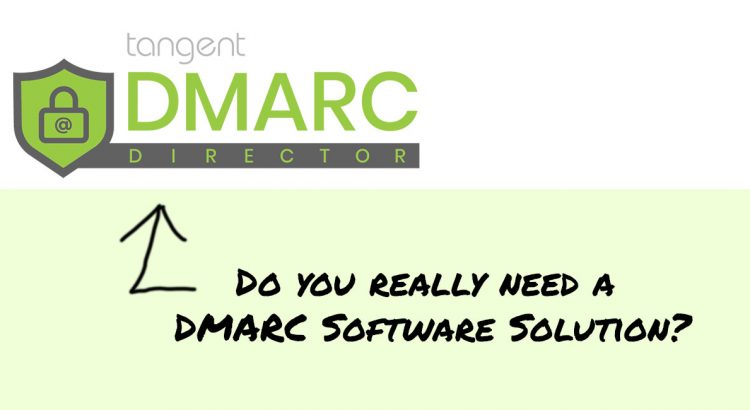
What is DMARC software and do you need it?
In layman’s terms, DMARC prevents email from spoofing and protects email attacks such as phishing and email fraud. To implement DMARC, one would need to set up, monitor and review their DMARC policy.
That’s where things can get sticky. Now, unless you’re a programmer, and love looking at code constantly. A Matrix looking screen may not be the ideal way to help you set up DMARC.
Screen from the movie The Matrix.
Actual DMARC record:
DMARC Defined Technically:
DMARC (Domain-based Message Authentication, Reporting, and Conformance) is a standard email authentication protocol used to protect against email-based attacks such as phishing and email fraud. DMARC assists in preventing email spoofing.
DMARC Software:
DMARC software refers to the tools, services, or solutions that implement DMARC authentication and provide reporting and conformance features. In other words, DMARC Software helps end users set up DMARC policy, then review emails that see if they met the desired policy- a DMARC Checker.
DMARC Software makes it easy to visually determine harmful emails from benign ones and determine if changes to the policy should be made.
DMARC Director screen image:
DMARC software typically includes the following components:
DMARC Authentication:
DMARC allows email senders to authenticate their emails using mechanisms such as Sender Policy Framework (SPF) and DomainKeys Identified Mail (DKIM). DMARC software helps set up and configure SPF and DKIM for a domain to ensure that only legitimate senders can send emails on behalf of that domain.
DMARC Reporting:
DMARC provides detailed reporting on email activity, including information on the sources of email, authentication results, and actions taken by email receivers. DMARC software generates these reports, which can help domain owners monitor their email traffic, detect and investigate unauthorized use of their domain, and take appropriate actions to enhance email security.
DMARC Conformance:
DMARC allows domain owners to specify how email receivers should handle emails that fail authentication (i.e., do not pass SPF or DKIM checks). DMARC software allows domain owners to set up policies for handling such emails, such as quarantining or rejecting them, and helps enforce these policies to achieve email authentication conformance.
DMARC Management:
DMARC software provides management capabilities for configuring and managing DMARC settings, policies, and reporting preferences. This includes setting up DMARC records in DNS, configuring SPF and DKIM, and managing DMARC policies for different domains or subdomains.
It is an unfortunate reality that one hears about organizations such as banks, schools,hospitals- and, everything in between- facing record breeches. Hackers are always trying to penetrate sensitive data for different reasons- and their success is often determined on the security protocol of their victims.
DMARC Software is NECESSARY
Would your business suffer if client information was compromised? Would your business suffer if it lost money due to theftThe resounding answer is yes. DMARC Software makes it easier to set up your DMARC Policy.
DMARC software is an absolute necessity to facilitate your business from being able to secure inbound and outbound emails.
What if I don’t know how to set up DMARC?
DMARC Director offers training to assist you with setting up your policy. Whether you’ve mastered DMARC protocols or not, DMARC Director will provide you with the tools you need to fully monitor and manage your DMARC Settings and emails.
DMARC Director allows you to view a live spoofing map so you can see what part of the world your threat emails are coming from.
DMARC Director’s dashboard is easy to read, understand and interpret. Our dashboard was made for the end user to successfully implement DMARC without needing to interpret endless XML files.
Overall, DMARC software helps organizations implement and manage DMARC authentication, reporting, and conformance to protect their domains from email spoofing and improve email security. It is often used in conjunction with other email security measures, such as spam filters, antivirus software, and employee training, to provide a multi-layered defense against email-based threats.
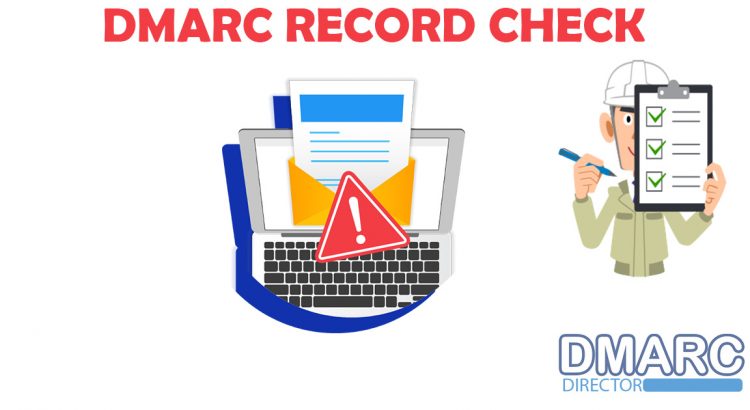
DMARC Record: A Powerful Tool to Protect Your Email Domain
Email has become an integral part of our lives, and it’s hard to imagine a world without it. However, with the convenience of email comes the challenge of securing it. Email spoofing and phishing attacks have become more sophisticated and prevalent, putting individuals and organizations at risk of data breaches and other cyber threats.
Fortunately, there are tools available to protect email domains from such attacks, and one of the most powerful is the DMARC record. In this blog post, we’ll discuss what a DMARC record is, how it works, and why it’s essential for your email domain’s security.
What is a DMARC record?
DMARC stands for Domain-based Message Authentication, Reporting, and Conformance. It’s an email authentication protocol that helps protect email domains from phishing and spoofing attacks. DMARC record is a DNS (Domain Name System) record that specifies how incoming email messages should be handled if they fail authentication checks.
DMARC record is composed of the following components:
- Policy: The policy component specifies how the email messages that fail authentication should be handled. The policy can be set to one of the following values: none, quarantine, or reject.
- Subdomain Policy: The subdomain policy component specifies how email messages from subdomains of your domain should be handled.
- Alignment: The alignment component specifies whether the domain’s DKIM (DomainKeys Identified Mail) and SPF (Sender Policy Framework) align with the domain in the “From” header.
- Reporting: The reporting component specifies how DMARC reports should be sent and to whom.
How does a DMARC record work?
When an email message is sent, it’s checked against the DMARC record published by the domain in the “From” header. The DMARC record specifies whether the email should be rejected, quarantined, or allowed. If the email fails the DMARC check, the receiving mail server can either reject it, quarantine it, or allow it to be delivered to the recipient’s inbox.
Why is a DMARC record essential for your email domain’s security?
- Prevents email spoofing: DMARC record helps prevent email spoofing by verifying the email’s authenticity through SPF and DKIM authentication mechanisms.
- Protects brand reputation: Email spoofing can damage your brand’s reputation, and DMARC record can help protect it by ensuring that only authenticated emails are sent from your domain.
- Improves email deliverability: DMARC record improves email deliverability by reducing the likelihood of emails being marked as spam or phishing messages.
- Provides visibility into email authentication: DMARC record provides visibility into email authentication by generating reports that show which emails passed or failed DMARC checks. This can help organizations identify and remediate issues with email authentication.
DMARC record is a powerful tool that can help protect your email domain from phishing and spoofing attacks, improve email deliverability, and protect your brand’s reputation. If you haven’t already implemented DMARC record for your email domain, it’s time to consider doing so. Remember, securing your email domain is crucial for safeguarding your personal and business information from cyber threats.
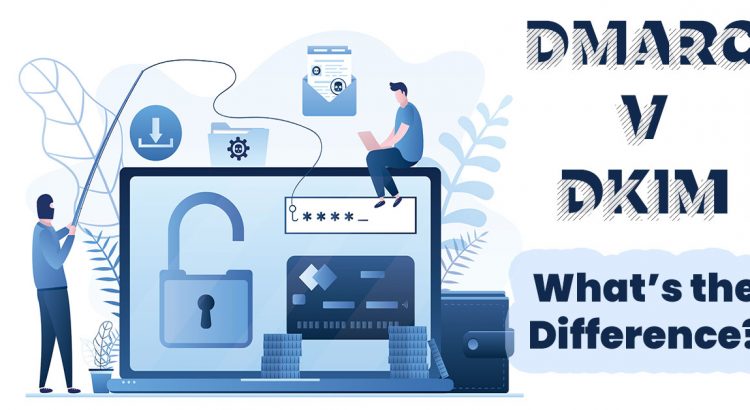
What is the difference between DKIM and DMARC?
As the number of cyber-attacks increases, it is essential to implement robust email authentication protocols to protect sensitive information from being accessed by unauthorized parties. Two such authentication protocols are DKIM (DomainKeys Identified Mail) and DMARC (Domain-based Message Authentication, Reporting, and Conformance). Although both these protocols are used to verify the authenticity of email messages, they have different functions. In this blog post, we will explore the difference between DKIM and DMARC.
What is DKIM?
DKIM is an email authentication protocol that is used to verify the authenticity of an email message by checking if the message was sent by an authorized sender. It works by adding a digital signature to the header of the email message. This digital signature is created using a private key that belongs to the sender’s domain. When the recipient receives the email message, their email client will use the sender’s public key to decrypt the digital signature and verify that the email was indeed sent by an authorized sender.
What is DMARC?
DMARC, on the other hand, is a policy-based email authentication protocol that is used to detect and prevent email spoofing. It is used to provide email domain owners with the ability to specify how their emails should be handled by the recipient’s email server if the message fails the DKIM or SPF (Sender Policy Framework) authentication checks. DMARC is a more advanced protocol than DKIM as it provides an extra layer of protection against domain spoofing.
Difference between DKIM and DMARC
While both DKIM and DMARC are used to verify the authenticity of email messages, there are some fundamental differences between the two protocols. The primary difference between DKIM and DMARC is their function. DKIM is used to add a digital signature to the header of the email message to verify its authenticity, whereas DMARC is used to detect and prevent email spoofing by providing email domain owners with policy-based controls.
Another difference between DKIM and DMARC is that DKIM only checks the authenticity of the email message header, while DMARC checks both the header and the body of the email message. This means that DMARC can provide more detailed information about the email’s origin, making it easier to detect and prevent email spoofing.
To summarize, while both DKIM and DMARC are essential email authentication protocols, they serve different functions. DKIM is used to verify the authenticity of an email message by adding a digital signature to the header, while DMARC is used to detect and prevent email spoofing by providing email domain owners with policy-based controls. As cyber-attacks become increasingly sophisticated, it is essential to implement robust email authentication protocols to protect sensitive information from being accessed by unauthorized parties. By implementing DKIM and DMARC, you can help ensure that your emails are secure and only accessible by authorized parties.
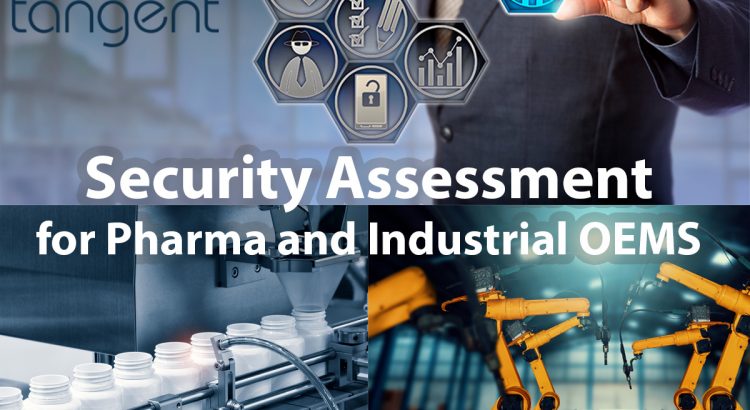
Security Assessments for Industrial and Pharmaceutical OEMs
DMARC is a security protocol that helps prevent email fraud and phishing attacks by allowing email recipients to verify that incoming messages are from an authorized sender. Enabling DMARC will stop your domain from being spoofed. It stands for Domain-based Message Authentication, Reporting, and Conformance. DMARC also enables senders to receive reports on how their email is being handled, allowing them to make improvements to their email authentication practices.
Pharmaceutical and industrial OEM companies are prime targets for cybercriminals because of the sensitive nature of their business operations. Cybercriminals may attempt to impersonate your brand in order to steal sensitive information, money, or intellectual property. They may also attempt to deliver malware or ransomware to your customers or employees through phishing emails that appear to come from your company.
As a pharmaceutical or industrial original equipment manufacturer (OEM) company, your brand is critical to your success. Protecting your brand reputation is vital to ensure that your customers trust your products. One way to do this is by implementing DMARC.
Here are Four reasons why you need a DMARC security assessment if you’re a pharmaceutical or industrial OEM company:
Boost your Email Security from Phishing:
The most sophisticated and successful phishing attacks use your domain. Phishing emails that seem to be sent from accounting departments and CEOs can be particularly hazardous and DMARC can stop them in their tracks.
Protect Your Brand Reputation:
Your brand is your most valuable asset. A successful phishing attack that uses your brand to trick customers into providing sensitive information can damage your reputation and erode the trust that your customers have in your products DMARC can help you identify vulnerabilities in your email authentication practices and implementing a stronger DMARC policy to prevent unauthorized emails from being delivered.
Ensure Regulatory Compliance:
The pharmaceutical and industrial OEM industries are heavily regulated, and failure to comply with regulations can result in severe penalties. DMARC compliance is required for some regulations, such as the EU’s General Data Protection Regulation (GDPR). A Tangent DMARC implementation can ensure that you’re compliant with these regulations.
Improve Email Deliverability:
DMARC can help improve your email deliverability by ensuring that your emails are authenticated and not marked as spam or phishing attempts. DMARC can identify issues that may be impacting your email deliverability and help you resolve them, ensuring that your legitimate emails are delivered to your clients’ inboxes.
Tangent offers a white glove implementation service making it easy to get started with DMARC. We use the aggregated report to find all of your sending sources, align your policy to make it easy to upgrade your policy to quarantine and eventually reject.
DMARC is essential for pharmaceutical and industrial OEM companies that want to protect their brand reputation, ensure regulatory compliance, and improve email deliverability.
Learn more at dmarc.tangent.com or call: (650) 535-3422
The Advantages and Limitations of Medical PCs in Clinical Settings
Medical PCs are specialized computers designed for use in healthcare facilities, such as hospitals, clinics, and doctor’s offices. These computers are specifically built to meet the unique needs of healthcare professionals and provide reliable, high-performance computing solutions in clinical settings. In this blog, we will explore the advantages and limitations of medical PCs in clinical settings.
Advantages of Medical PCs in Clinical Settings
Enhanced Data Security
Medical PCs are built with robust security features to safeguard sensitive patient data from cyber threats. These computers are equipped with advanced encryption protocols and access controls that prevent unauthorized access to patient records and other confidential data. Additionally, medical PCs are often equipped with biometric authentication systems, such as fingerprint scanners or facial recognition software, which further enhance data security and ensure that only authorized personnel can access sensitive patient information.
Improved Workflow Efficiency
Medical PCs are designed to improve workflow efficiency in clinical settings. These computers are equipped with specialized software that enables healthcare professionals to manage patient records, track medication, and schedule appointments more efficiently. Moreover, medical PCs are often integrated with other healthcare systems, such as electronic health records (EHRs) and clinical decision support tools, which streamline workflows and reduce administrative burdens for healthcare professionals.
High Performance and Durability
Medical PCs are built to withstand the demanding environments of clinical settings. These computers are constructed with high-quality components that ensure reliable, high-performance computing even in harsh conditions. Medical PCs are often designed to be dust-proof, water-resistant, and shock-resistant, which reduces the risk of damage from spills, falls, and other accidents that may occur in busy clinical environments. Furthermore, medical PCs are often equipped with powerful processors, ample memory, and high-speed storage, which enable healthcare professionals to run multiple applications simultaneously and access patient records quickly and efficiently.
Versatility
Medical PCs are versatile computing solutions that can be customized to meet the unique needs of healthcare facilities. These computers can be configured with a wide range of hardware and software options, including touchscreen displays, barcode scanners, and RFID readers, which enable healthcare professionals to perform a variety of tasks and manage patient care more efficiently. Furthermore, medical PCs can be mounted on carts or walls, which allows for greater flexibility in clinical settings.
Limitations of Medical PCs in Clinical Settings
- Cost
Medical PCs can be expensive compared to standard desktop computers. The cost of medical PCs is typically higher due to the specialized components and features required to meet the demands of clinical settings. While the higher cost of medical PCs can be justified by the increased efficiency and productivity they provide, it can be a barrier for smaller healthcare facilities with limited budgets.
- Maintenance
Medical PCs require regular maintenance to ensure they remain in optimal working condition. Healthcare facilities must ensure that medical PCs are regularly cleaned, updated, and serviced to prevent malfunctions and ensure reliable performance. Moreover, medical PCs require specialized technical support, which can be costly and time-consuming for healthcare facilities.
- Training
Healthcare professionals must be trained to use medical PCs effectively. While medical PCs are designed to be user-friendly, healthcare professionals must understand how to use the specialized software and features to maximize their efficiency and productivity. This training can be time-consuming and expensive, particularly for larger healthcare facilities with numerous employees.
Medical PCs offer a range of advantages in clinical settings, including enhanced data security, improved workflow efficiency, high performance, durability, and versatility. While there are limitations to medical PCs, such as cost, maintenance, and training requirements, the benefits they provide make them an indispensable tool for healthcare professionals. Ultimately, healthcare facilities must weigh the advantages and limitations of medical PCs and determine whether they are the best computing solution for their unique needs.
